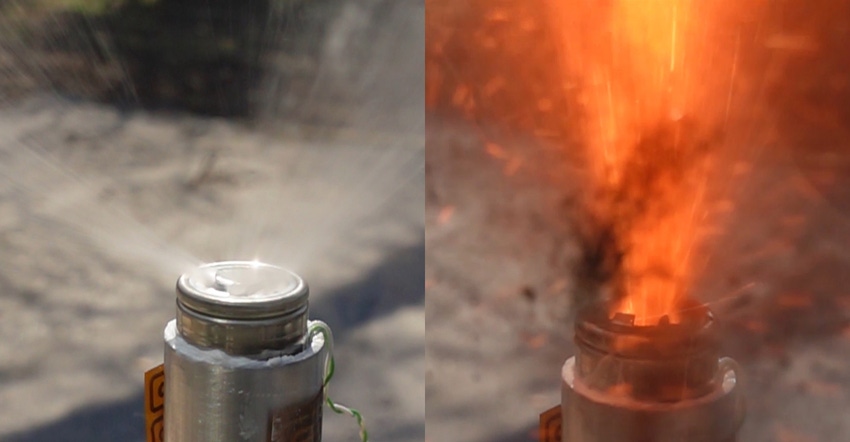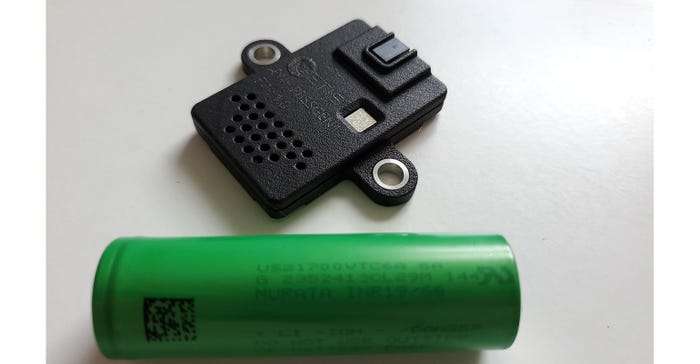A safety device from Metis has been certified for use in the auto industry to detect cell venting, an early stage of thermal runaway that can lead to fire.
October 21, 2022

A UK-based company has developed a sensor that can monitor the health of a lithium-ion battery pack for potential catastrophic failure to prevent serious problems that can occur in the device before they happen.
Metis Engineering has successfully certified its Production Battery Safety Sensor to ISO Automotive Standards with an independent test house, Applus+ 3C Test, and in-house test capability, the company said.
The certification provides confidence for EV manufacturers that the product can be used to monitor the health of EV batteries for use in battery packs being manufactured across the commercial vehicle industry, Jules Tipler business development lead, told Battery Technology.
The sensor originally was designed as part of research and development for electric racing cars and electric aircraft; however, Metis created a slimmed-down, mass-production version due to industry demand, the company said.
“The wider EV Industry needs to know to what standard the components in a system are rated to,” Tipler explained in an email interview. “This is key to everything from building battery packs for tier ones and OEMs, as it is for insurance and reassurance to the end users and the customers.”
While EV battery packs already have a battery management system (BMS) fitted to keep track of the battery's health, it is typically limited to temperature sensors—one for every few cells—and by monitoring for voltage changes.
This system is sufficient to protect a battery if the cell that goes bad happens to be one with a temperature sensor on it, Tipler said. However, if the cell is a distance away from the sensor in the pack, by the time the sensor registers the change in temperature, if at all, it would very likely be too late.
Early-detection
Metis' sensor measures pressure change and in particular volatile organic compounds (VOCs) in the batteries to detect cell venting—an early stage of thermal runaway—within seconds.
Thermal runaway begins first with an increase in temperature that means the battery is overworked, has a manufacturing fault, or is showing its age, Tipler said. This causes the pressure inside the battery cell to rise and, if it gets high enough, causes venting from the sealed battery cell.

“If load is not removed from the cell,then a thermal runaway can occur,” he said. This can drive the battery to failure, which can cause it to can catch fire in a self-oxidizing reaction. This then likely results in a runaway reaction that sets off the cells around it, causing the total loss of the vehicle and even its passengers, Tipler warned.
This early detection, then, “is vital to the safety of the vehicle’s passengers and everything in the immediate proximity,” he said. “The early warning of a thermal incident could save lives and property.”
Added protection
The Metis Production Battery Safety Sensor also has other features to monitor humidity, dew point, and air temperature parameters required to ensure that the battery continues to operate optimally, according to Metis.
These additional monitoring mechanisms are important because battery packs get warm when they are charged or discharged, so they are typically cooled in some way to prevent overheating. If they are cooled below the ambient temperature, however, they can dip below the dew point—or the temperature at which the air can’t carry moisture and it condenses onto cooler surfaces—which could lead to shorting and thermal incidents.
By monitoring these other environmental factors, the sensor can trigger a warning before condensation settles on the battery or other component, Tipler explained.
“Metis Battery Safety Sensors are designed to give next-level EV battery health monitoring above and beyond that offered by a traditional BMS,” he said.
The sensor itself is about the size of a match box and contains a number of other key monitoring components which, when cross checked with one another, ensure a false positive doesn’t occur so that a cell venting warning isn’t given in error, according to Metis. The sensors also include VOC detection, pressure, moisture and an optional accelerometer.
The accelerometer can monitor shock loads up to 24G and impact duration that the battery pack may experience, showing both whether the pack experienced loadings above safe levels and for what duration. This can help manufacturers determine if a battery pack need service or should be removed or recycled, according to Metis.
Reaching the EV market
So far, Metis has seen the sensor being deployed by customers ranging from those developing electric buses—which need very early warning of a thermal event in case the vehicle has to be evacuated—to electric trucks and racing cars, in which high-voltage systems are being worked hard, Tipler said.
“We also have customers from test houses all over the world where new cell chemistries and EV packs are tested to the limits in abuse chambers,” he told us.
Ultimately, Metis expects that the certification will now expand the customer base to include OEMs of a full range of EVs who are seeking added battery monitoring protection, Tipler added.
Elizabeth Montalbano is a freelance writer, journalist and therapeutic writing mentor with more than 25 years of professional experience. Her areas of expertise include technology, business and culture.
About the Author(s)
You May Also Like





